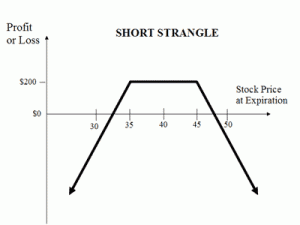The Short Strangle, is a very similar option trading strategy to a Short Straddle and is the complete reversal of a Long Strangle. Learning the Long Strangle first makes the Short Strangle easier to understand.The Short Strangle strategy is similar to the Short Straddle strategy, except you sell the call option(s) and the put option(s) at different strike prices. When entering a Short Strangle position an investor will sell (short) a certain number of out-of-the-money (OTM) call contracts while simultaneously selling (shorting) the same number of out-of-the-money put contracts for the same target month. Like the Short Straddle position the Short Strangle position has a set maximum profit and potentially unlimited risk if the stock goes against you.
Risk: Limited
Reward: Limited
The Trade: Sell out of the money calls and puts
Options – Short Strangle
When to use: You believe the stock will move in a range or sideways type price action. This strategy is similar to selling a Straddle but the premium received is smaller. But then a larger move either way is needed to show a loss.
Which options to sell (or how far away from the underlying price) depends on what type of range you expect. Expecting a tight range, nearer the money. Expecting a wide range then further out-of-the-money.
Volatility expectation: Very bearish, a decrease in volatility will work marvels for the position.
Profit: The profit potential is limited but a substantial and sudden move can turn this trade into a big loser especially if one of the sold options goes ‘into the money’. But generally considered as a more cautious trade than a ‘Short straddle’.
Loss: Unlimited for a sharp move in the underlying in either direction.
Breakeven: Occurs if the underlying expires below strike A or above strike B by the same amount as the premium received in establishing the position.
Time decay: This position is a big wasting asset therefore time decay helps enormously. But if volatility increases, erosion slows, if volatility decreases, erosion speeds up.
